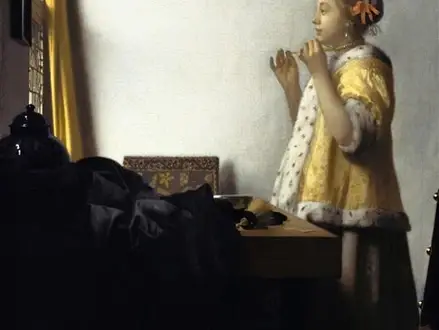Title of Artwork: “Young Woman with a Pearl Necklace”

Artwork by Johannes Vermeer
Year Created 1662
Summary of Young Woman with a Pearl Necklace
Dutch artist Johannes Vermeer painted this portrait of a woman in her late twenties. Vermeer depicted a young Dutch woman, most likely of upper-class descent, dressed in two yellow ribbons, pearl earrings, and a pearl necklace in oils on canvas.
This can be seen in many of Vermeer’s paintings of interiors and domestic scenes from his time in the Dutch Golden Age, when he was extremely popular. For the love letter and the letter writing lady, the same woman appears.
All About Young Woman with a Pearl Necklace
When it comes to Dutch painting, Johannes Vermeer is among the country’s best-known artists. Vermeer developed a distinct style for his many domestic paintings because of his focus on interior scenes. A favourite among Holland’s upper-middle-class patrons, Vermeer provided a window into the world of the country’s intellectual elite.
His baptism and life in Delft, where he was brought up and married by a Catholic woman by the name of Catherine Bolnes, have been documented by historians, despite the fact that little else is known or proven about Vermeer’s life. He may have converted to Catholicism as a result of this marriage.
Vermeer’s paintings as an innkeeper and art dealer have numerous characteristics that can be identified. In addition to the use of yellow and blue tones, wall coverings (such as maps and artwork), depictions of women and household tools, heavy drapery, light angles from the left and prominent and telling facial expressions, these characteristics are also present. In this way, Vermeer was able to idealise Dutch women and their values. A true Vermeer painting has the following characteristics: Girl with a Pearl Earring; The Love Letter; The Art of Painting; and The Love Letter.
An unidentified young Dutch woman is depicted in this 21 5/8 X 17 34 inch painting from 1664 as she looks left toward a window’s light source. An upper-class family most likely owns this young lady’s yellow fur-trimmed coat. For example, it features a yellow draped curtain, framed pictures on the wall, a light source coming in from the left, and an expressive face.
An illustration of this is the use of a yellow, drawn-back curtain on the far left side of the stage. By completing the woman’s jacket in a rich shade of lemon yellow, Vermeer achieves harmony in his painting. He painted a woman holding a water jug in front of a window, and that’s what the curtain would look like covering that same window.
That same wall, Vermeer has a framed mirror on display. Wealth and status are likely signified by the ebony frame. Vermeer’s use of a mirror is also noteworthy. To convey the woman’s vanity or feminine power, Vermeer used a sense of reflection. Because of Vermeer’s fascination with certain Greek muses, he often incorporated a mirror into his paintings to suggest duality. However, other historians, citing the Essential Vermeer Website, believe that this mirror represents the Dutch concept of vanitas, or the memory of death. But there is no one-size-fits-all method for determining this.
Information Citations
En.wikipedia.org, https://en.wikipedia.org/.
























